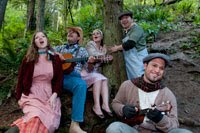 In the November 2009 issue of Harper's Magazine, there's a terrific essay by Arthur Krystal, entitled THE WORST OF TIMES: Revisiting the Great Depression.
In the November 2009 issue of Harper's Magazine, there's a terrific essay by Arthur Krystal, entitled THE WORST OF TIMES: Revisiting the Great Depression.The essay quotes Morris Dickstein, author of Dancing in the Dark: A Cultural History of the Great Depression:
"Trying to grasp the essential spirit of the thirties would seem to be a hopeless task...How can one era have produced both Woody Guthrie and Rudy Vallee, both the Rockettes high-stepping at the Radio City Music Hall and the oakies on their desperate trek toward the pastures of plenty in California?"
Dickstein calls this the "split personality of Depression culture".
So, one week before opening night, when the inevitable questions rise about what we've created and whether we took the correct path of inquiry, this essay arrives as a good omen, a reminder that Canta y no llores is, at the very least, accurate. We've woven in all those multiple personalities, and thrown in the Day of the Dead to boot!
Woody Guthrie and Busby Berkeley? Check.
Political, sentimental and funny? Check.
Bilingual and bicultural? Check.







